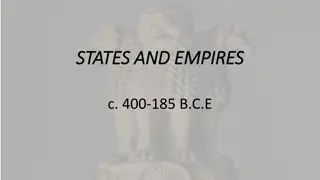Ancient Wonders of Epidaurus and Nafplion
Explore the historical significance of Epidaurus, known for its sanctuary and well-preserved theater, dedicated to Asclepius, the healing god. Discover the beauty and acoustics of the ancient theater of Epidaurus, still used for performances today. Journey to Nafplion, the former capital of Greece, with its traditional architecture and rich history dating back to the Greek Revolution. Walk through the old town to immerse yourself in the historical charm of these ancient Greek destinations.
Download Presentation

Please find below an Image/Link to download the presentation.
The content on the website is provided AS IS for your information and personal use only. It may not be sold, licensed, or shared on other websites without obtaining consent from the author.If you encounter any issues during the download, it is possible that the publisher has removed the file from their server.
You are allowed to download the files provided on this website for personal or commercial use, subject to the condition that they are used lawfully. All files are the property of their respective owners.
The content on the website is provided AS IS for your information and personal use only. It may not be sold, licensed, or shared on other websites without obtaining consent from the author.
E N D
Presentation Transcript
Visit to Epidaurus and Nafplion
Epidaurus was known for its sanctuary situated about five miles (8 km) from the town, as well as its theater, which is once again in use today.
Asclepius, the most important healer god of antiquity, brought prosperity to the sanctuary. In the peaceful hinterland of Epidaurus, with its mild climate and abundant mineral springs, is the sanctuary of the god-physician Asklepios, the most famous healing centre of the Greek and Roman world. The sanctuary belonged to the small coastal town of Epidaurus, but its fame and recognition quickly spread beyond the limits of the Argolid. It is considered the birthplace of medicine and is thought to have had more than two hundred dependent spas in the eastern Mediterranean. Its monuments, true masterpieces of ancient Greek art, are a precious testimony to the practice of medicine in antiquity.
Probably the most beautiful and best preserved of its kind, the theater of Epidaurus was built in the 4th century BC by Polyklitos, around the time when Athens was flourishing in art, philosophy, science and of course theatre and can seat more than 13,000 spectators. Due to its excellent acoustics and condition, the ancient theatre is still used today, most notably under the framework of the annual Epidaurus Festival.
The prosperity brought by the Asclepeion enabled Epidaurus to construct civic monuments, including the huge theatre that delighted Pausanias for its symmetry and beauty, used again today for dramatic performances and a palaestra.
Nafplio is a seaport town in the Peloponnese in Greece that has expanded up the hillsides near the north end of the Argolic Gulf. The town was the first capital of the First Hellenic Republic and of the Kingdom of Greece, from the start of the Greek Revolution in 1821 until 1834.
Walking with the history, in the old town, you can easily release the important days this place lived. Nafplio maintains a traditional architectural style with many traditional-style colourful buildings and houses, influenced by the Venetians, Nafplio maintains a traditional architectural style with many traditional- style colourful buildings and houses, influenced by the Venetians, because of the domination of 1338 1540.
Around the city can be found several sculptures and statues. They are related mostly with the modern history of Nafplio, such as the statues of Ioannis Kapodistrias and Theodoros Kolokotronis.
Nafplio enjoys a very sunny and mild climate, even by Greek standards, and as a consequence has become a popular day or weekend road-trip destination for Athenians.
The Acronauplia is the oldest part of the city of Nafplion in Greece. Until the thirteenth century, it was a town on its own. The arrival of the Venetians and the Franks transformed it into part of the town fortifications. The arrival of the Venetians and the Franks transformed it into part of the town fortifications. Other fortifications of the city include the Palamidi and Bourtzi, which is located in the middle of the harbor.
The fortress was a very large and ambitious project, but was finished within a relatively short period from 1711 until 1714 Not only was the Palamidi a great fortress, it was also the site of a dismal prison. In 1833, during the time of the regency, when King Otto was still a minor, one of the leaders of the revolution, Theodoros Kolokotronis, was imprisoned here on the supposed charge of high treason.
Thank you for your attention































